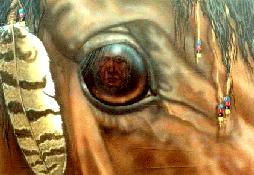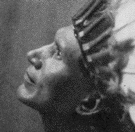 |
|
|---|---|
The Soul of the IndianAn Interpretation by Dr Charles Alexander Eastman, 1911
| |

| Editorial |
 |
|
|---|---|
The Soul of the IndianAn Interpretation by Dr Charles Alexander Eastman, 1911
| |

| Editorial |
In All Ages and in All Lands ... |
|---|
In the preface to his newest translation of the classic The Life of Apollonius of Tyana (by Philostratus in 220AD) its editor, James Loeb, in 1912 wrote:
Inclusive of this work by Charles Eastman, "The Soul of the Indian", the editor has strived to engineer WWW solutions towards these means so that all - in particular those Students of Life - may learn of the nature of life in both the Inner World and the Outer World.
For those who have the ears to hear the words of Eastman concerning the nature of the soul and the nature of nature are no different from those expressed 5600 years earlier in the Vedas, 3200 years earlier in the Upanishads, 2400 years earlier by Buddha and Lao Tsu in the East and Pythagoras and other PreSocratics in the West, 1900 years earlier by Jesus and Apollonius, 1400 years earlier by Mohammed .... and the precedents continue down to the modern days ... such as the words of the contemporary scientist and mystic Guru Ji collected in a book entitled "The Science of the Soul"
Modern man - if he is to truly comprehend the nature of the Outer World and the nature of the Inner World, and the relativity of these two realms of existence - must learn to become a student of nature. As difficult as it may appear, the materialistic and man-made confusions of the Age must be set aside, and the student must contemplate that which is simply natural - in the same manner as did the wiser elders of the native Americans, or the native Australians, or the native South Pacific Islanders - indeed the indigenous peoples of the planet.
Has it ever occurred to the twentieth century Western world that the most ancient Greek roots were a profound expression of the indigenous understanding of nature? The greatest ancient statesmen constantly and forever sought the secrets of life and existence within the living terrestrial world of nature. Their common wisdom was passed down to us concerning this eternal nature - interfaced in some mysterious manner - to the eternal cosmic world of the sky. Those who contemplated the nature of nature around them became the earliest scientists, sages and saints.
Like mountains on a plain they stand head and shoulders above their contemporaries. And when in retrospect, we look back at the words these great men have left, we see that they lead us back into the foothills of experience and towards the higher peaks of terrestrial and cosmic existence. All the greatest of these men on this planet spoke of, and attempted to understand the nature of the soul ... And in this task, Charles Alexander Eastman, born Ohiyesa of the Sioux, has proudly and clearly spoken - and to my sensibilities has spoken of the soul of man just as profoundly as have the earlier and ancient visionaries before him.
Scientific "Laws of Nature" ... |
|---|
Modern man has seen the Eagle land on the moon but does he inately possess an indigenous understanding of himself, and his relationship to the planet Earth? Does he understand that the earth and the moon are a binary system in orbit about the central cosmic fire of life? Does he realise that the terrestrial nature of the Earth - into which he was born, and into which he shall surely pass away - is part of him even as he takes each next breath of air, each next drink of water, each next meal of food - and each thought and feeling? Does he have any comprehension of the nature of his own soul?
The huge complexities and technological systematics of man-made inventions have been embodied in the physical world, as motor cars, aeroplanes, radio, TV, space flight, computer communications and the internet. The specifications which relate to the understanding of these man-made things have generated the vast theoretical and intellectual frameworks which are prevalent in the modern education systems of today. Yet the specification of the ultimate nature of nature is not forthcoming from the scientific or mathematical disciplines, or the theological disciplines.
Is the nature of nature to be understood by the intellectual derivation and understanding of complex mathematical systems? Is the Gaia Hypothesis to be understood only in a scientific sense? The history of science and modern civilisation is counter-mythological ... nature has been slowly and methodically de-mystified to the satisfaction of the educated pundits.
However is modern science now itself steeped in the metaphoric myth of the machine, to the extent that this skews its view of the world in subtle but systematic ways? We don't even consider that other operative metaphors may be equally appropriate -- organic metaphors, in particular -- natural metaphors ...
Perhaps it will be seen that the "Great Mystery" spoken of so eloquently in this work by Eastman is not to be specified by that which is exceedingly complex. That which is of fundamental importance and relevance to the human condition cannot in essence be far removed from the nature of life - natural life - foundational and elemental existence.
Peace.
 | About the Author | |
|---|---|---|
Charles Alexamnder Eastman (1858-1939) was a Wahpeton (Santee) Sioux who attended Dartmouth College and Boston University Medical School. He was the first Native American to hold a position of authority at the Pine Ridge Agency, where he was a doctor. While working at the reservation, he witnessed the Ghost Dance movement, and he was one of the first people to visit Wounded Knee after the massacre. Active in the YMCA and one of the founders of the Boy Scouts of America, Eastman's civic-mindedness (and his ability to move comfortably in both white and Indian society) led him to co-found the Society of American Indians in Columbus, Ohio, in 1911.
Elsewhere, in another book Indian Heroes and Great Chieftains, he reveals the extent of his travels - both with his people and with his nation - during the years of the later part of the nineteenth century as civilisation made its relentless advance across the lands of the Native America:
Every age, every race, has its leaders and heroes. There were over sixty distinct tribes of Indians on this continent, each of which boasted its notable men. The names and deeds of some of these men will live in American history, yet in the true sense they are unknown, because misunderstood. I should like to present some of the greatest chiefs of modern times in the light of the native character and ideals, believing that the American people will gladly do them tardy justice.
It is matter of history that the Sioux nation, to which I belong, was originally friendly to the Caucasian peoples which it met in succession-first, to the south the Spaniards; then the French, on the Mississippi River and along the Great Lakes; later the English, and finally the Americans. This powerful tribe then roamed over the whole extent of the Mississippi valley, between that river and the Rockies. Their usages and government united the various bands more closely than was the case with many of the neighboring tribes.
During the early part of the nineteenth century, chiefs such as Wabashaw, Redwing, and Little Six among the eastern Sioux, Conquering Bear, Man-Afraid-of-His-Horse, and Hump of the western bands, were the last of the old type. After these, we have a coterie of new leaders, products of the new conditions brought about by close contact with the conquering race.
This distinction must be borne in mind -- that while the early chiefs were spokesmen and leaders in the simplest sense, possessing no real authority, those who headed their tribes during the transition period were more or less rulers and more or less politicians. It is a singular fact that many of the "chiefs", well known as such to the American public, were not chiefs at all according to the accepted usages of their tribesmen. Their prominence was simply the result of an abnormal situation, in which representatives of the United States Government made use of them for a definite purpose. In a few cases, where a chief met with a violent death, some ambitious man has taken advantage of the confusion to thrust himself upon the tribe and, perhaps with outside help, has succeeded in usurping the leadership.
Other Books by the Author |
|---|
Other books to have been published by this man are as follows:
 Indian Boyhood: FULL-E-TEXT from the University of Virginia Etext Archive
Indian Boyhood: FULL-E-TEXT from the University of Virginia Etext Archive
 Old Indian Days: FULL-E-TEXT from the University of Virginia Etext Archive
Old Indian Days: FULL-E-TEXT from the University of Virginia Etext Archive
 Native American Literature Online: WebPage Index of many writings, inclusive of the above two books.
Native American Literature Online: WebPage Index of many writings, inclusive of the above two books.
 Indian Heroes and Great Chieftains: FULL-E-TEXT from the Project Gutenburg Etext Archive
Indian Heroes and Great Chieftains: FULL-E-TEXT from the Project Gutenburg Etext Archive
 Indian Heroes and Great Chieftains: Selected sketches of some of the great Native American leaders, from Glenn Welker.
Indian Heroes and Great Chieftains: Selected sketches of some of the great Native American leaders, from Glenn Welker.
 From the Deep Woods to Civilization - Web reference not known.
From the Deep Woods to Civilization - Web reference not known.
 |
|
|---|
Index
FwdCh1Ch2Ch3Ch4Ch5Ch6ED
Crd
 Web Publication by Mountain Man Graphics, Australia in the Southern Autumn of 1996 | |||||||||||||||||||||||||||||
|---|---|---|---|---|---|---|---|---|---|---|---|---|---|---|---|---|---|---|---|---|---|---|---|---|---|---|---|---|---|